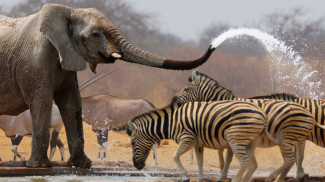You can't think of an elephant without immediately picturing its long trunk. But what do Elephants-Are-Endangered.html">elephants do with these strange, slender appendages? Where do they get it? With some less extreme exceptions, such as tapirs, elephant trunks are appendages unlike anything else in the animal kingdom.

What is an elephant trunk?
An elephant's trunk is an extended trunk that merges with the upper lip. They have opposite "fingers" at the end for grasping small objects. One way to differentiate between elephant species is by the number of these fingers: African Elephants-Are-Endangered.html">elephants have two, while Asian Elephants-Are-Endangered.html">elephants have only one. These fingers are so powerful and precise that an elephant can pick up a small peanut, break the shell, and eat the uncrushed nut inside.
Because it has no supporting bones, the 2-meter-long torso must support its own weight and the weight of anything it picks up with 150,000 individual muscle fibers that make up its internal structure. Rings of cartilage support both nostrils and extend all the way to the torso, where they can weigh up to 160 kilograms and be able to lift more than twice that amount!
It also points out that some elephants have a preferred side of their trunks, just like our right or left-handedness. Some mammoth ivory fossils also show that they rested by covering their trunks over their favorite tusks.
Feeding and watering
One of the main functions of the elephant trunk is eating and drinking. With two tall pillar legs and a big and heavy head, it is very laborious to bend down or reach out!
Long trunks alleviate this problem, allowing elephants to graze on the ground or trees without moving their heads. They can also suck up nearly 14 liters of water and squirt it into their mouths.
As strict vegetarians, elephants are large and need to consume and digest large amounts of food every day. The trunks can serve their purpose by independently searching and retrieving more food as their wide, flat molars process fibrous plant material into digestible pulp. When you're an elephant, there's no need to stop chewing to eat grass!
fragrance
An elephant's sense of smell is four times greater than that of a hound, and its periscope trunk allows it to locate friends and relatives, potential predators, and food or water sources. Its length and flexibility also allow it to keenly interpret the direction of scent. Also, this is useful when you don't want to move a huge head.
Social and communication
By changing the shape and size of their nostrils, elephants can control their trumpets in order to communicate with other individuals in the herd, sending messages to competitors or even members of other species.
Elephants can often be seen with other elephants, especially friends or family, entwining their trunks in a greeting similar to a human handshake or hug.
evolution
All of this brings us to how luggage was originally developed.
Short trunks such as tapirs are not very useful for prehensile purposes, making them difficult to select and improve over successive generations. For a full-grown elephant, half a trunk doesn’t do much good!
One theory is that tree trunks may have originally evolved as snorkels for breathing underwater. This will prove useful as it can be used for many of the functions mentioned above. A case of "chicken and the egg" in the pachyderm world.
Some of the elephant's closest relatives are Manatees-Are-Endangered.html">manatees and dugongs, whose lifestyles were entirely aquatic, suggesting that elephants' ancestors may have been even more aquatic than they are today. Further evidence suggests that the male elephant's penis is held internally when not erect, which is generally unusual among land mammals.
To round out the argument, elephant lungs are even adapted to withstand water pressure while snorkeling. While humans can only use a foot-long snorkel due to the pressure on their lungs, elephants have a layer of dense tissue between their lungs and chest that prevents their lungs from collapsing.
Perhaps elephant trunks are a throwback to a previous water-based existence, and their use on land is a coincidental asset that would otherwise be difficult to exploit? Regardless of how the elephant acquired its remarkable trunk, I'm sure we can all agree that it's an enviable appendage.
animal tags:
We created this article in conjunction with AI technology, then made sure it was fact-checked and edited by a Animals Top editor.